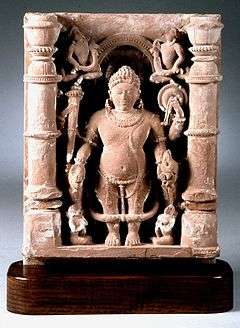Vamana
| Vamana | |
|---|---|
 Four-armed Vamana | |
| Devanagari | वामन |
| Sanskrit transliteration | Vāmana |
| Affiliation | Human dwarf and fifth Avatar of Vishnu |
| Weapon | Wooden umbrella and water pot |
Vamana (Devanagari: वामन, IAST: Vāmana, lit. dwarf) is described in the Puranas as the fifth avatar of Vishnu, and the first incarnation of the Second Age or Treta yuga.[1] He is the first avatar to appear as a human, although he does appear as a dwarf Brahmin.
Etymology
- Vamana (वामन) = a dwarf
- Upendra (उपेन्द्र) = younger brother of Indra
- Trivikrama (त्रिविक्रम) = one who strode over the three worlds (Svarga, Earth and Patala) in three steps
Origin
Aditi took Payovrata to propitiate Lord Vishnu. As a result, Vamana was born to Aditi and Kashyapa.[2] He is the twelfth of the Adityas.
Hinduism

The Bhagavata Purana describes that Vishnu descended as the Vamana avatar to restore the authority of Indra over the heavens, as it had been taken by Mahabali, a benevolent Asura King. Bali was the great grandson of Hiranyakshipu, the grand son of Prahlada and son of Virochana.
Vamana, in the guise of a short Brahmin carrying a wooden umbrella, went to the king to request three paces of land. Mahabali consented, against the warning of his guru, Sukracharya. Vamana then revealed his identity and enlarged to gigantic proportions to stride over the three worlds. He stepped from heaven to earth with the first step, from earth to the netherworld with the second. King Mahabali, unable to fulfill his promise, offered his head for the third.
Vamana then placed his foot and gave the king immortality for his humility.[3] He was also allowed to return every year to see the citizens of his country. The festival of Onam for some and first day of [Diwali] for some is related to this return of Mahabali.
Mahabali is seen as a symbol of prosperity and love. In worshiping Mahabali and his ancestor Prahláda, he conceded sovereignty of Pátála, the netherworld. Some texts also report that Vamana did not step into the netherworld, and instead gave its rule to Bali. In giant form, Vamana is known as Trivikrama.[4]
Symbolism
- Mahabali symbolizes Samridhi mean prosperity, the three feet symbolizes the three planes of existence (Jagrat, Swapna and Sushupti) and final step is on his head which elevates from all three states and he attains moksha.[4]
Temples
The Vamana temples are located in
- Thrikkakara Temple, Thrikkakkara, Cochin, Kerala
- Ulagalantha Perumal Temple, Kanchipuram in Kanchipuram
- Vamana Temple, Eastern Group of Temples, Khajuraho, Madhya Pradesh
- Ulagalantha Perumal Temple, Tirukoyilur in Tirukoilur, Viluppuram district, Tamil Nadu
- Vaman Temple in Renwal Manji, Jaipur district, Rajasthan
 Vamana avatar with King bali
Vamana avatar with King bali
 Vishnu as Trivikrama, Mahabalipuram relief
Vishnu as Trivikrama, Mahabalipuram relief
See also
| Part of a series on |
| Vaishnavism |
|---|
 |
|
Sampradayas |
|
Philosophers–acharyas |
|
Related traditions |
|
|
![]() Media related to Vamana at Wikimedia Commons
Media related to Vamana at Wikimedia Commons
- Dashavatara
- Vishnu Purana
- Onam
- Bhagavata Purana
- Vishnu
- Varaha
- Parashurama
- Rama
- Krishna
- Buddha
- Kalki
- Vamadeva
References
- ↑ "Vamana Avatar: Vishnu's Fifth Incarnation". Retrieved 6 November 2008.
- ↑ Account of the several Manus and Manwantaras Vishnu Purana, translated by Horace Hayman Wilson, 1840, Book III: Chapter I. 265:22, at the request of the deities Vishńu was born as a midget, Vámana, the son of Adití by Kaśyapa. By applying to Mahabali for alms Kaśyapa was promised by the prince whatever he might demand, notwithstanding Śukra (the preceptor of the Daityas). The dwarf demanded as much space as he could step over at three steps and upon the assent of Mahabali he enlarged himself to such dimensions as to stride over the three worlds. Being worshipped however by Mahabali and his ancestor Prahláda, he conceded to them the sovereignty of Pátála.
- ↑ Gopal, Madan (1990). K.S. Gautam, ed. India through the ages. Publication Division, Ministry of Information and Broadcasting, Government of India. p. 74.
- 1 2 Chandra, Suresh (Aug 15, 2012). Encyclopaedia of Hindu Gods and Goddesses. Kindle Edition.
External links
- Vamana Temples in Kerala
- Complete Story of Bali
- Srimad Bhagavatam 8.18: Lord Vamanadeva, the Dwarf Incarnation
- Vamana Avatar
- Story of Vamana Avataram